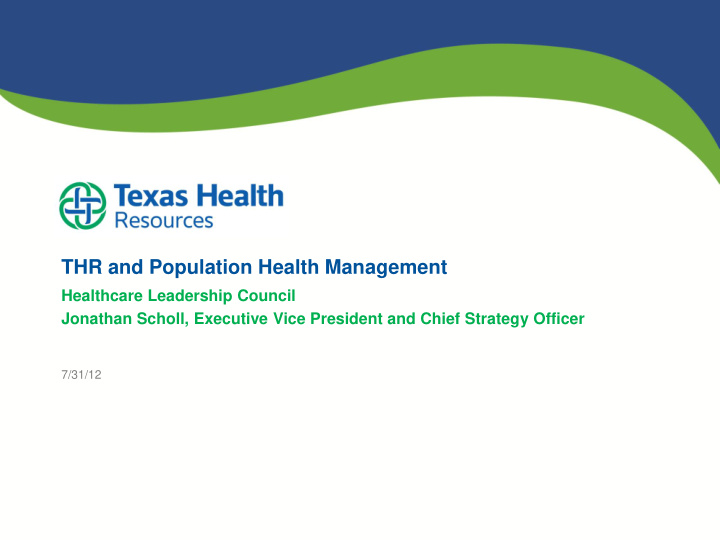



THR and Population Health Management Healthcare Leadership Council Jonathan Scholl, Executive Vice President and Chief Strategy Officer 7/31/12
Texas Health Resources – Who we are • Our Mission: “ To improve the health of the people in the communities we serve” • One of the largest faith-based, nonprofit health systems in the United States. • Includes the Texas Health Presbyterian, Texas Health Arlington Memorial and Texas Health Harris Methodist hospitals of North Texas, a large physician group (THPG), outpatient facilities, and home health, preventive and fitness services. • More than 5,500 physicians with active staff privileges * • $3.75 billion in total operating revenue** North Texas • $4.6 billion in total assets* * Fiscal year 2011 ** Physicians on the medical staff practice independently and are not employees or agents of the hospital or Texas Health Resources. 7/27/2012 2
Health is more than just the absence of illness “Health is a state of complete physical, mental and social well-being and not merely the absence of disease or infirmity.” April, 1948 Preamble to the Constitution of the World Health Organization as adopted by the International Health Conference, New York, 19-22 June, 1946; signed on 22 July 1946 by the representatives of 61 States (Official Records of the World Health Organization, no. 2, p. 100) and entered into force on 7 April 1948. 3
A person's well- being is what is ‘good for’ them; the notion of how well a person's life is going for that person Community Financial Physical Social Emotional Career 4
Unfortunately, providing access to care only impacts ~10% of those factors that influence overall health Health behaviors Other Providing access to care US healthcare 88% 8% 4% 100% expenditures Influencers 10% 20% 20% 50% 100% of Health Providing Environment Genetics Health behaviors (e.g., workplace, (e.g., life style, food access home, geography) choices, exercise, etc.) to care Source: Centers for Diseases Control and Prevention, University of California at San Francisco, Institute for the Future Healthcare providers are best positioned to address health behaviors, but our historical spend has been primarily focused on access 5
Value proposition: Individuals with higher well-being cost less and perform better Increase total Improve Reduce total Increase economic value Well-being medical cost performance • States • Hospitalizations • Productivity Adopt or maintain healthy behaviors • Communities • Event rates • Engagement Reduce health-related • Sponsors • Disease rates • Absence risks • Individuals • Lifestyle risks • Work impairment Optimize care for health conditions and disease • Prevent or delay next new case of disease or condition Economic • Prevent or reduce impact of the next new episode of care drivers • Enhance one’s ability to actively manage their well -being 6
Well-being can be measured through the research and science behind the Well-Being Index TM • More than 1,000 new interviews with U.S. adults each day Top Quintile 2 nd Quintile 3 rd Quintile 4 th Quintile 5 th Quintile Within state of Texas Source: 2011 Gallup-Healthways WBI Community Data 7
Improving well-being has economic benefits Five-year, cumulative cost savings through interventions in modifiable behaviors • Each intervention contributes to incremental savings • By introducing comprehensive wellness programs that address all eight behaviors: • Medical costs reduced by 13.40% • Productivity costs reduced by 8.06% • Total costs reduced by 10.99% Source: Healthways Simulation model with multiple public data inputs www.healthways.com 8 8
Changing behaviors can begin with physician/clinician-led interventions Meet Janet Today Future “Managing cases ” “Managing causes ” A physician’s schedule has 25, 10 minute With evidenced-based care plans and a system to support… appointments with no system to manage the entire panel… • The physician reviews appointment schedule • Physician has limited time to see patient to identify areas that need special attention • One major complaint is addressed, i.e. low • Janet receives counseling and loses 8 lbs. back pain through a weight loss coaching program. • Brief examination reveals the need for a • Physician reminds Janet that it was really couple of prescriptions, i.e., muscle relaxant good she was able to reduce her level of and pain relief stress and get into an exercise program. • Not enough time to discuss issues of weight, • stress, or other concerns Behavior change becomes the new focus of • Janet leaves with issues not addressed; the office visit. Janet feels her physician really physician/clinician feels rushed cares about her overall health and not just her back pain. The physician feels he is really making a difference, not only for this patient but for all his patients. 9
THR and Healthways, partnering with physicians, is making this vision come alive in N. Texas Define the most important actions and interventions Assess the population Provide clinicians with tools / resources to better 1 2 3 understand patient High cost Mitigable Disease population and claimants events mgmt. workflow • Keep well people well • Treat chronic disease • Take care of problems Clinician creates Lower customized care costs plan with interventional support Less illness and infirmity Healthier people 10
Truly improving the health of a population will require engagement of multiple stakeholders Customer : “Any person or institution that takes risk for healthcare outcomes” “I keep myself healthy using Consumers THR tools and programs” Employers Plans “I control my healthcare costs using THR tools and programs” Exchanges Communities One need in common across all: Mitigating healthcare risk by improving health and well-being 11
THR and Population Health Management Healthcare Leadership Council Jonathan Scholl, Executive Vice President and Chief Strategy Officer 7/31/12
Recommend
More recommend